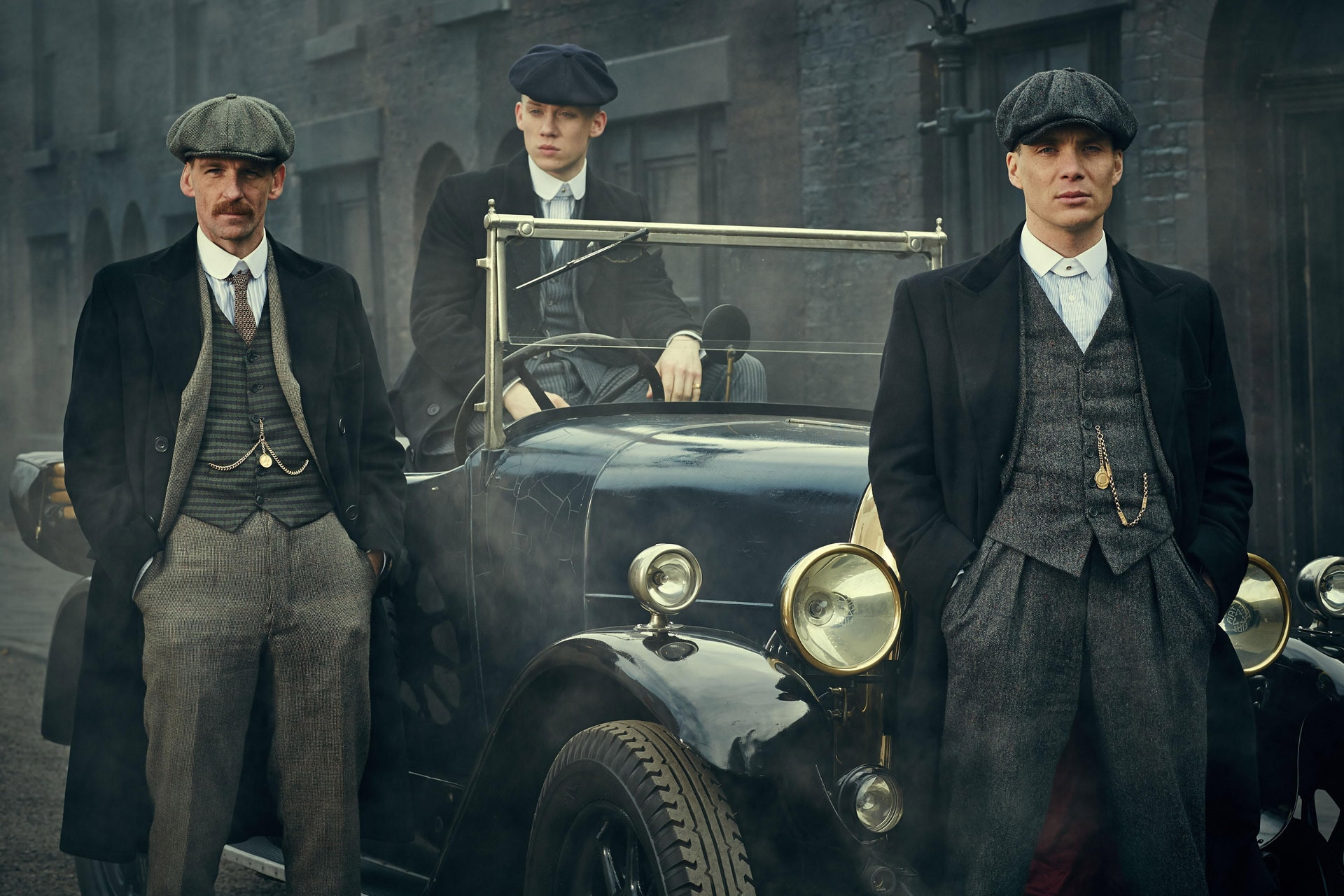Introduction
What if a single flat cap hid a razor blade sharp enough to slash through history’s underbelly? Peaky Blinders, the gritty BBC drama, turns that myth into a mesmerizing saga of post-WWI crime and ambition. Premiering in 2013, this series has hooked millions with its razor-edged storytelling and iconic style—proving gangsters can be poets too.
Table of Contents
- Historical Roots
- Series Overview
- Main Cast
- Season Breakdown
- Themes and Style
- Awards and Impact
- The Movie and Beyond
- Q&A on Peaky Blinders
- Summary
:max_bytes(150000):strip_icc():focal(939x372:941x374)/peaky-blinders-1-a40fc8c2b1b74d358ae212d75c0ea013.jpg)
The Cast of ‘Peaky Blinders:’ Where Are They Now?
Historical Roots
Peaky Blinders draws from a real Birmingham gang terrorizing the industrial heart of England from the 1880s to the 1920s. These working-class youths, often orphans or factory lads, ruled Small Heath with fists and fear. The name? “Peaky” for their peaked flat caps, “Blinders” possibly from blinding enemies with sewn-in razor blades—though historians debate if that was urban legend or brutal fact.
In the late 19th century, Birmingham’s economic boom bred poverty and vice. Factories churned out metal goods, but workers scraped by in slums. The real Peaky Blinders clashed with rivals like the Kimber gang over turf, betting pitches, and protection rackets. Police mugshots from the era show dapper lads in tweed suits, sporting stylish bobs and monocles—a far cry from Hollywood thugs.
- Key Historical Facts:
- Active peak: 1910s–1920s, fading with economic shifts.
- Signature look: Tailored suits, bell-bottom trousers, and those infamous caps.
- Crimes: Street fights, theft, race-fixing—mirroring the show’s empire-building.
Creator Steven Knight, a Birmingham native, fictionalized this for TV, blending fact with flair. The real gang’s demise came from police crackdowns and the Great War’s toll, but their legend endures, inspiring everything from punk fashion to this blockbuster series.
Teaching something new: The razor-in-cap myth likely stemmed from 1920s tabloids exaggerating fights, but evidence points to bicycle chains as their real weapon of choice.
[Image placeholder: Vintage mugshots of real Peaky Blinders members in 1920s attire.]

The History of the Real Peaky Blinders | HistoryExtra
Short paragraphs keep the grit flowing: Peaky Blinders honors these roots without romanticizing—showing how war-traumatized vets like Tommy Shelby channeled rage into reinvention.
Series Overview
Peaky Blinders is a British crime drama created by Steven Knight, airing on BBC Two from 2013 to 2022. Set against Birmingham’s smoky canals and pubs, it chronicles the Shelby family’s rise from street hoods to political powerhouses. Each 60-minute episode pulses with tension, blending gang wars, family feuds, and forbidden romances.
The show’s hook? Anachronistic soundtrack—Nick Cave, The White Stripes—clashing with 1920s visuals for a modern edge. Directed by talents like Otto Bathurst, it boasts cinematography that turns industrial decay into art: fog-shrouded streets lit by gas lamps, evoking noir poetry.
Produced by Caryn Mandabach and Tiger Aspect, it spans six seasons and 36 episodes. Available on Netflix globally, it’s binged by over 10 million in the U.S. alone. Knight’s script masterfully weaves historical events—like the 1926 General Strike—into personal vendettas.
- Production Highlights:
- Budget per season: Escalated to £10 million by Series 6.
- Filming locations: Liverpool’s docks doubled for Birmingham.
- Languages: English, with Yiddish and Romany dialects for authenticity.
Peaky Blinders isn’t just TV; it’s a cultural export, spawning fan tours in Birmingham and razor-cap replicas. Its value? It humanizes villains, teaching that ambition in adversity forges legends—or graves.
[Image placeholder: Behind-the-scenes shot of the Shelby family set in a recreated 1920s pub.]
Main Cast
At the heart of Peaky Blinders beats an ensemble of raw talent. Cillian Murphy stars as Thomas “Tommy” Shelby, the brooding war hero turned gang leader. His ice-blue stare and clipped Brummie accent make Tommy a tragic anti-hero—ruthless yet haunted by trench nightmares.
Helen McCrory (RIP 2021) slays as Aunt Polly Gray, the chain-smoking matriarch whose cunning rivals Tommy’s. Paul Anderson chews scenery as Arthur Shelby, the volatile hothead brother, while Sophie Rundle grounds the saga as Ada, the socialist sister fighting for equality.
- Core Cast Breakdown:
- Cillian Murphy (Tommy Shelby): Nominated for four BAFTAs; his Oppenheimer Oscar nods to this role’s depth.
- Paul Anderson (Arthur Shelby): Brings manic energy, drawing from real Brummie toughs.
- Helen McCrory (Polly Gray): Emmy-worthy ferocity; her death prompted poignant Series 6 tributes.
- Sophie Rundle (Ada Shelby): Evolves from rebel to MP, embodying women’s interwar rise.
- Joe Cole (John Shelby): Charismatic wildcard, exiting dramatically in Series 4.
Guest stars shine too: Sam Neill as the vengeful Chief Inspector Campbell, Tom Hardy as the enigmatic Alfie Solomons. Their powerhouse performances elevate Peaky Blinders from genre fare to acting masterclass.
Expert opinion: Director Anthony Byrne calls the cast “alchemists,” turning Knight’s words into visceral emotion—proving chemistry trumps plot twists.

Series 6 Trailer
Value add: Murphy improvised Tommy’s cigarette habit, adding authenticity—smoke signals his inner turmoil.
Season Breakdown
Peaky Blinders unfolds across decades, each season a chapter in the Shelby ascent. Season 1 (1919) drops us into post-WWI chaos: Tommy uncovers stolen guns, sparking a feud with IRA agents and cop Campbell. Six episodes build to a bloody racecourse showdown.
Season 2 (1921–1922) expands to London, pitting Shelbys against Italian mobsters. Tommy’s parliamentary ambitions emerge amid opium dens and May Day riots. Highlights: Alfie Solomons’ debut, blending Yiddish wit with brutality.
- Season Highlights:
- Season 3 (1924): Global stakes with Russian exiles and a sapphire heist; Grace’s arc peaks tragically.
- Season 4 (1925–1926): New York Mafia vendetta; introduces Luca Changretta (Adrien Brody), culminating in the General Strike.
- Season 5 (1929): Wall Street Crash and fascist intrigue; Oswald Mosley (Sam Claflin) tempts Tommy politically.
- Season 6 (1933–1934): WWII looms; Boston ties and Polly’s absence hit hard, ending on a vengeful cliffhanger.
Each finale ups the ante—weddings turn massacres, deals dissolve in gunfire. Knight paces like a boxer: jabs of dialogue, hooks of betrayal.
Teaching new: Seasons align with real events, like the 1926 strike, showing how economics fueled extremism—lessons echoing today.
[Image placeholder: Montage of key scenes from each season, with timestamps.]
Themes and Style
Peaky Blinders dissects power’s poison: Loyalty fractures under greed, trauma festers into tyranny. Family is both anchor and noose—Shelbys kill for kin, yet betray in whispers. Gender flips norms: Polly wields ledgers like guns, Ada votes while men brawl.
Visually, it’s a feast. Costumes by Alison McCosh layer tweed with menace—double-breasted coats hide holsters. Sets recreate Birmingham’s grit: canals reek of coal, pubs echo with folk songs. The score? Modern rock over period strings, amplifying isolation.
- Stylistic Gems:
- Cinematography: Slow-motion gunfights in sepia tones evoke silent films.
- Symbolism: Tommy’s cigarette = vulnerability; the blue horse = doom.
- Cultural Clash: Brummie dialect vs. posh accents highlights class wars.
Expert opinion: Knight views it as “a poem about my city,” using style to romanticize resilience amid despair. Value: It teaches interwar history viscerally—fascism’s roots in inequality.
The razors? Symbolic of hidden edges in every character.
How Peaky Blinders is Inspiring Classic Suit Trends Today | GQ Australia
Awards and Impact
Peaky Blinders racked up accolades, proving its cultural punch. It snagged the 2022 National Television Award for Returning Drama, with Murphy winning Drama Performance. BAFTAs hailed its craft: Best Drama Series (2018), Cinematography (2014).
Globally, it’s spawned fashion lines (flat caps at Topman), tours (Birmingham’s Black Country Museum), and memes (“By order of the Peaky Blinders”). Viewership peaked at 5 million UK per episode; Netflix streams topped charts.
- Major Wins:
- BAFTA Craft Awards: Director (2014), Makeup (multiple years).
- National Television Awards: Best Series (2019, 2020).
- NME Award: Best TV Show (2020).
Impact? Revived interest in Brummie heritage, boosting tourism by 20%. Critics praise its diversity: Romany roots, queer undertones in later seasons.
[Image placeholder: Award ceremony photo of the cast holding NTAs.]
The Movie and Beyond
Series 6 bowed out in 2022, but Peaky Blinders marches on. Knight announced a feature film in 2021, delayed to 2023 production amid strikes, now eyeing 2025 release. Set in WWII, it follows Tommy against fascists—expect bombs, betrayals, and Barry Keoghan joining the fray.
Spin-offs loom: Knight teases connected series, perhaps Ada in America or young Shelbys. Netflix’s deep pockets fuel expansions.
- Future Teasers:
- Film Plot: Tommy vs. Mosley in 1930s Europe.
- Casting Rumors: Murphy returns; new faces for aged roles.
- Themes: War’s long shadow, redemption arcs.
Expert opinion: Murphy says the movie will “close the circle,” teaching closure’s elusiveness in endless cycles of violence.
[Image placeholder: Concept art for the Peaky Blinders movie, with wartime Tommy.]

Tommy’s OG (Original Peaky Razor)
Q&A on Peaky Blinders
Q: Is Peaky Blinders based on true events? A: Loosely—real gang inspired the name and style, but Shelbys are fictional. Knight amplified myths for drama.
Q: Why the modern music? A: Knight wanted emotional resonance over period accuracy—Arctic Monkeys underscore Tommy’s turmoil.
Q: Best season for newcomers? A: Season 1 hooks with origins; binge all for family depth.
Q: Razor caps real? A: Debated—likely exaggerated, but caps were status symbols.
Q: Movie release date? A: Slated for late 2025; WWII setting amps stakes.
[Image placeholder: Fan Q&A graphic with Tommy quotes.]
Summary
Peaky Blinders masterfully blends history, heart, and havoc into a six-season triumph, with a film extending the Shelby saga. From Birmingham backstreets to fascist fronts, it explores ambition’s double edge through stellar casts like Murphy’s Tommy and McCrory’s Polly. Key takeaways: Style as armor, family as fate, and myths as mirrors. Awards affirm its legacy; visuals and vibes ensure immortality. Stream on Netflix—by order of the Peaky Blinders.
External Link: Official Peaky Blinders on Netflix – Trailers, seasons, and behind-the-scenes


